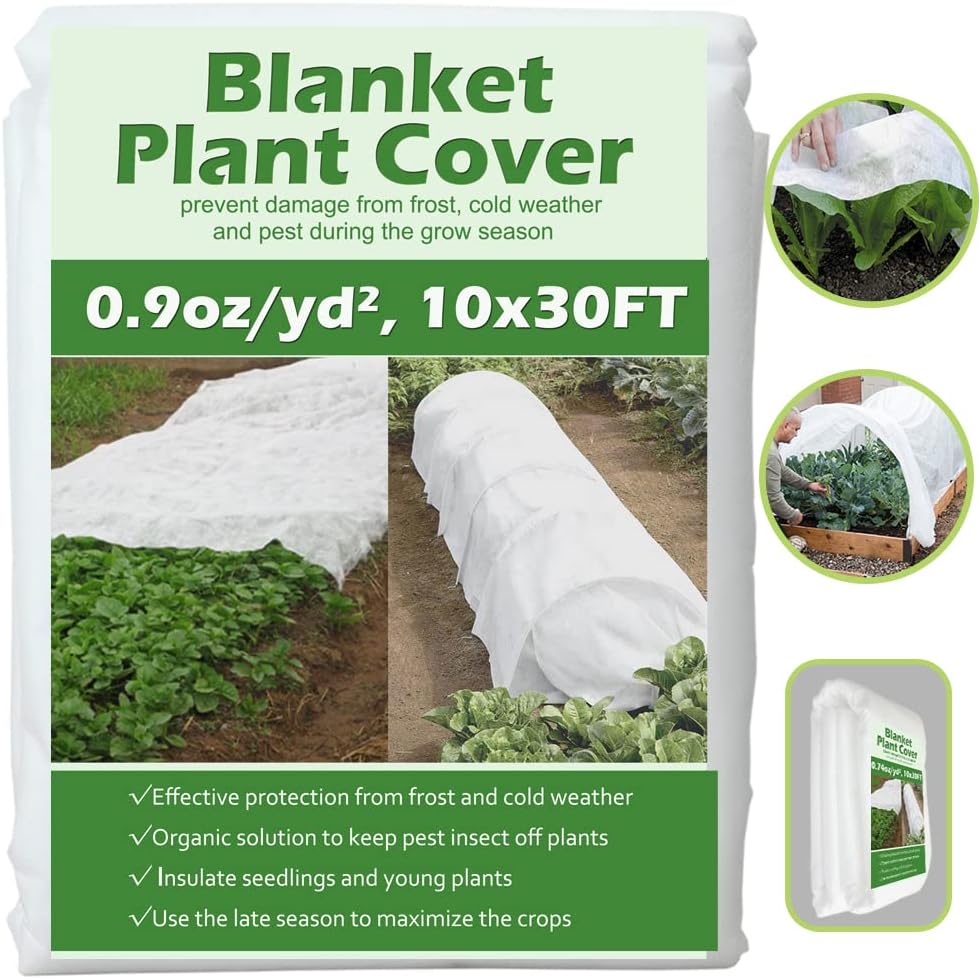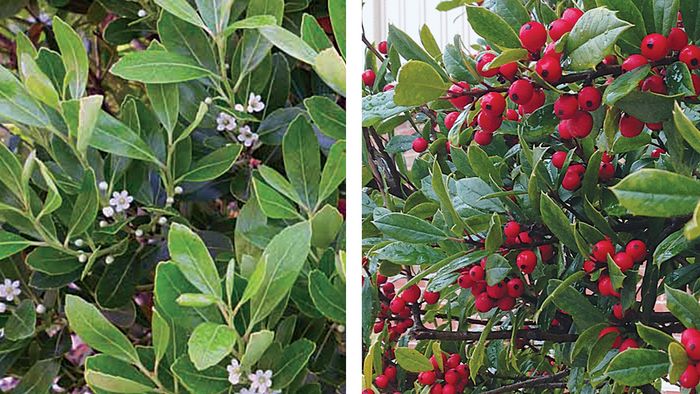
No one wants to sit in their backyard and stare at a fence, no matter how pretty it is. I have been designing gardens for decades, and not once has someone said, “I want a view of the fence.” The traditional response is to camouflage the fence with a hedge of identical green shrubs. As gardeners, however, we know there is a better approach. When confronted with the fence in my own backyard, I considered it an opportunity to create a border using distinctive shapes, colors, and textures. The result is a bright, low-maintenance border that is attractive in all seasons, whether I am viewing it from inside the house or outside on my patio.
Undulating lines create the illusion of movement
I began by giving my border enough depth to be able to sustain some larger trees and shrubs that will not outgrow their place when they reach maturity. My fence-camouflaging border is 100 feet long (the full length of my property) and is 6 to 8 feet deep in varied sections. At the far-end corner it is 15 feet deep. By creating a bed that can fit larger plants, I have the ability to layer the plantings so they look natural and parklike rather than like a line of tall plants crammed into a narrow space in an obvious attempt to screen the fence.
This deep bed gives the trees and shrubs the space they need to mature naturally, which means I can avoid regularly pruning the woodies away from the lawn or walkway. (Trust me: You’ll be glad in the future that you made your garden beds deeper and sacrificed a little lawn.)
Rarely do we see perfectly straight lines in nature, so rather than echoing the straight line created by the fence, I gave my border a serpentine edge to provide the illusion of movement. This strategy naturally draws the eye along the length of the bed and away from the fence. This shape also gives the impression that the border has a greater length. When choosing my plants, I selected species that would fill, yet stay inside, an imaginary vertical boundary to ensure the border kept its intended flowing form both vertically and horizontally.
A recipe for building an engaging border


When it comes to designing a garden, everyone has site-specific goals in mind. No matter if your top goal is improving a view or masking an eyesore, the strategies for creating a high-performance border are the same. Keep these principles in mind, and you’ll be well on your way to creating a beautiful and lasting view.
1. Give beds extra depth
Providing adequate space for trees and shrubs allows the plantings to be layered dynamically instead of being placed in an unnatural, rigid lineup.
2. Choose a limited color palette
Sticking with a simple set of hues echoed along the border keeps the scene unified and orderly.
3. Don’t use straight lines
Curving the bed edge along a fence leads to more space to plant and a better visual flow.
4. Select plants for year-round interest
Choosing most of your plants for multiseason interest provides the best display for the least amount of effort.
5. Include varied textures
Selecting different plants with glossy, muted, wide, and narrow foliage adds an intriguing interplay of dimension.
Discover Stacie’s favorite plants for hiding a fence.
Find a list of plant IDs for this beautiful back border.
A plant palette that is mostly evergreen masks the fence throughout the year

When selecting plants for a fence-line border, I make at least three-quarters of the plantings evergreen. My goal is to hide the fence as much as possible without creating the look of a fortress. The evergreens, of course, create interest in winter while still blocking the fence. The remaining quarter of the plants I choose are selected for seasonal interest from spring through fall. Keep in mind that this evergreen and deciduous plant material balance also means less work. The less deciduous plant material you choose for your border, the less cleanup you will have to do at the end of fall.
When using mostly evergreen plants to provide fence coverage all year round, try to stagger your deciduous foliage and perennial bloom times so that you have color pockets throughout the seasons. Remember, though, that too much color will create the opposite effect and visually slice up your border or look chaotic.
If you are serious about creating a bed with as little maintenance as possible, choose your perennials wisely, opting for plants that don’t need deadheading or staking. The perennials I use are what I call “touch me once” plants. After a plant goes dormant in fall, I cut it down. That perennial will need to care for itself until the following fall.
Simple flowing colors create a harmonious view
While evergreen plants do the lion’s share of the work, do not think that they all need to actually be green. I like to intersperse engaging evergreen foliage like that found on gold-variegated ‘Aureomarginatus’ Japanese euonymus, golden ‘Sekkan-sugi’ Japanese cedar, and silver-colored ‘Blue Star’ juniper and ‘Big Ears’ lambs’ ears. Evergreen ‘Blanchard’ Southern magnolia also gives my border reflective qualities with its glossy foliage. This approach ensures that the border is highlighted with contrasting foliage that adds all-year interest.
I also like to use color to create an illusion that the border has more length to it. By repeating combinations of colors in groups, your eye moves along and then pauses at these areas unconsciously. This doesn’t necessarily mean repeating the same plants, just the same hues. For example, rich wine to deep purple tones can be echoed with the foliage of ‘Royal Purple’ smokebush and Diabolo® ninebark (Physocarpus opulifolius ‘Monlo’, Zones 3–7) and the redder foliage of Golden Ruby® barberry and ‘Moon Bay’ heavenly bamboo in fall, while a play on yellow or golden foliage can be enjoyed by planting Tiger Eyes® sumac, ‘Clemson Variegated’ silverberry, and Magic Carpet® spirea.
If you follow this basic formula your success is guaranteed, because you will have created a beautiful border with year-round color, texture, and interest—and you will have hidden that fence you started out with.
Stacie Crooks is a landscape designer and educator in Edmonds, Washington. She specializes in drought-tolerant designs.
From Fine Gardening #208
Fine Gardening Recommended Products

Plant Covers Freeze Protection 10 ft x 30 ft Floating Row Cover 0.9oz/yd²
Fine Gardening receives a commission for items purchased through links on this site, including Amazon Associates and other affiliate advertising programs.

The New Organic Grower, 3rd Edition: A Master's Manual of Tools and Techniques for the Home and Market Gardener, 30th Anniversary Edition
Fine Gardening receives a commission for items purchased through links on this site, including Amazon Associates and other affiliate advertising programs.

A.M. Leonard Deluxe Soil Knife & Leather Sheath Combo
Fine Gardening receives a commission for items purchased through links on this site, including Amazon Associates and other affiliate advertising programs.


















Comments
Log in or create an account to post a comment.
Sign up Log in